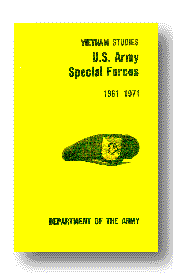This page briefly addresses the slow process of entanglement that lead to Special Forces involvement in Viet Nam.
History of Special Forces in Vietnam: Fighting the Ten-Year War

Most of the information on this page was extracted from Army book cited below.
Vietnam Studies
U.S. Army Special Forces 1961-1971
CMH Publication 90-23
Department of the Army
Washington, D.C. 1989 (First Printed, 1973)
The source document can be found here:
Source Document
You are encouraged to read the source document for additional insight.
Only a couple excerpts are presented here for emphasis.
"On 21 September 1961 the 5th Special Forces Group, 1st Special Forces, which would eventually be charged with the
conduct of all Special Forces operations in Vietnam, was activated at Fort Bragg. It was at this point, in the fall of 1961, that
President Kennedy began to display particular interest in the Special Forces. His enthusiasm, based on his conviction that the
Special Forces had great potential as a counterinsurgency force, led him to become a very powerful advocate for the development of
the Special Forces program within the Army. President Kennedy himself made a visit to the Special Warfare Center in the fall
of 1961 to review the program, and it was by his authorization that Special Forces troops were allowed to wear the distinctive
headgear that became the symbol of the Special Forces, the Green Beret."
Page 5
"Camp security occupied a major portion of the Special Forces detachment's time and effort. Few fortified
camps were built in the early part of the program, but as it evolved the new camps were placed in "hot areas" and therefore
required much more attention in both defense and security. Throughout the period, the Viet Cong harassed campsites and attacked
several in reinforced battalion strength, with occasional success. After the successful attack on the camp at Hiep Hoa in
November 1963, more emphasis was placed on making the camps strongly fortified positions."
Page 15
"One of the primary missions of Special Forces men at a camp was to advise and assist in the training of
paramilitary forces recruited in that area. The Special Forces training program generally concentrated on strike force troops,
although the Special Forces did participate in the training of hamlet militia, mountain scouts, and other irregular forces."
Page 15
As one of the two Communications personnel, I had little to do with training CIDG or Vietnamese personnel. From my perspective one of the A-team's primary missions was intelligence gathering and reconnaissance. The reconnaissance was conducted by 3- to 9-day patrols conducted by two SF personnel and about thirty (30) Vietnamese/CIDG -- and no interpreter!.
